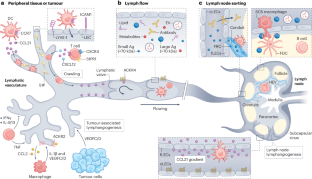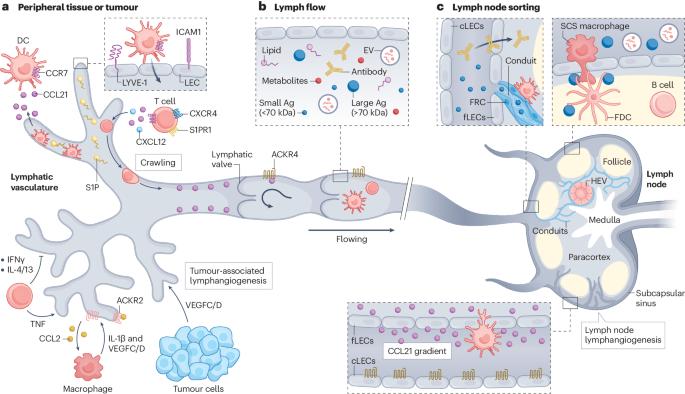癌症免疫疗法时代的淋巴管
IF 72.5
1区 医学
Q1 ONCOLOGY
引用次数: 0
摘要
淋巴运输维持着人体的平衡健康,是免疫监视所必需的,但淋巴的生长往往与实体瘤的发展和扩散有关。尽管人们最初认为肿瘤相关淋巴管重塑和生长只是为区域转移拓展了一条被动途径,但新兴研究将淋巴管及其主动运输置于转移、肿瘤相关炎症和全身免疫监视的交界处。在这里,我们将讨论淋巴管塑造其运输功能以影响外周组织免疫的主动机制,以及目前对肿瘤相关淋巴管如何增强和破坏抗肿瘤免疫监视的理解。最后,我们展望了淋巴管及其运输功能可能是关键角色的癌症免疫疗法领域的新兴领域:三级淋巴结构的形成、中枢神经系统的免疫监视、微生物组、肥胖和老化。汲取的经验教训支持了一个工作框架,该框架将淋巴系统定义为局部和全身炎症网络的关键决定因素,从而成为癌症免疫疗法反应中的关键角色。本文章由计算机程序翻译,如有差异,请以英文原文为准。


Lymphatic vessels in the age of cancer immunotherapy
Lymphatic transport maintains homeostatic health and is necessary for immune surveillance, and yet lymphatic growth is often associated with solid tumour development and dissemination. Although tumour-associated lymphatic remodelling and growth were initially presumed to simply expand a passive route for regional metastasis, emerging research puts lymphatic vessels and their active transport at the interface of metastasis, tumour-associated inflammation and systemic immune surveillance. Here, we discuss active mechanisms through which lymphatic vessels shape their transport function to influence peripheral tissue immunity and the current understanding of how tumour-associated lymphatic vessels may both augment and disrupt antitumour immune surveillance. We end by looking forward to emerging areas of interest in the field of cancer immunotherapy in which lymphatic vessels and their transport function are likely key players: the formation of tertiary lymphoid structures, immune surveillance in the central nervous system, the microbiome, obesity and ageing. The lessons learnt support a working framework that defines the lymphatic system as a key determinant of both local and systemic inflammatory networks and thereby a crucial player in the response to cancer immunotherapy. Tumour-associated lymphatic growth and remodelling were once viewed as a passive means by which cancer cells could regionally spread to lymph nodes. However, recent data point to an active and contrasting role for lymphatic vessels and their transport in antitumour immune surveillance. In this Review, Karakousi et al. provide a working framework to define this role for the lymphatic system in tumour progression and present avenues for its therapeutic manipulation to improve cancer immunotherapy.
求助全文
通过发布文献求助,成功后即可免费获取论文全文。
去求助
来源期刊

Nature Reviews Cancer
医学-肿瘤学
CiteScore
111.90
自引率
0.40%
发文量
97
审稿时长
6-12 weeks
期刊介绍:
Nature Reviews Cancer, a part of the Nature Reviews portfolio of journals, aims to be the premier source of reviews and commentaries for the scientific communities it serves. The correct abbreviation for abstracting and indexing purposes is Nat. Rev. Cancer. The international standard serial numbers (ISSN) for Nature Reviews Cancer are 1474-175X (print) and 1474-1768 (online). Unlike other journals, Nature Reviews Cancer does not have an external editorial board. Instead, all editorial decisions are made by a team of full-time professional editors who are PhD-level scientists. The journal publishes Research Highlights, Comments, Reviews, and Perspectives relevant to cancer researchers, ensuring that the articles reach the widest possible audience due to their broad scope.
 求助内容:
求助内容: 应助结果提醒方式:
应助结果提醒方式:


